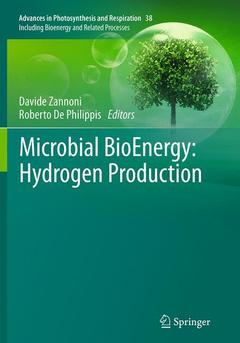Microbial BioEnergy: Hydrogen Production, Softcover reprint of the original 1st ed. 2014 Hydrogen Production Advances in Photosynthesis and Respiration Series, Vol. 38
Coordonnateurs : Zannoni Davide, De Philippis Roberto

The central theme of this book ?Microbial BioEnergy: Hydrogen Production? is focused on the biological machinery that microorganisms use to produce hydrogen gas. The book summarizes the achievements over the past decade in the biochemistry, structural and molecular biology, genomics and applied aspects of microbial H2-production, including microbial fuel cells (MFC), by phototrophs such as purple sulfur and non-sulfur bacteria (Thiocapsa spp., Rhodobacter and Rhodopseudomonas spp.) microalgae (Chlamydomonas) and cyanobacteria (Anabaena spp.) along with anaerobes and thermophiles such as Caldicellulosiruptor and Thermotoga. This is the first book of this series entirely devoted to microbial bio-hydrogen production and is intended to be a precious source of information for PhD students, researchers and undergraduates from disciplines such as microbiology, biochemistry, biotechnology, photochemistry and chemical engineering, interested in basic and applied sciences.
Preface.– 1. Bioenergy from Micro-organisms: an overview; Patrick C. Hallenbeck.- 2.Structural foundations for O2 sensitivity and O2 tolerance in [NiFe]-hydrogenases; Anne Volbeda, Juan C. Fontecilla-Camps.– 3. Engineering hydrogenases for H2 Production: Bolts and Goals; Marc Rousset, Pierre-Pol Liebgott.– 4. H2 production using cyanobacteria/cyanobacterial hydrogenases: from classical to synthetic biology approaches; Catarina C. Pacheco et al.- 5.Hydrogen Production by Water Biophotolysis; Maria L. Ghirardi et al.- 6. Nitrogenase-dependent Hydrogen Production by Cyanobacteria; Hermann Bothe, William E. Newton.– 7. Systems biology of photobiological hydrogen production by purple non-sulfur bacteria; James B. McKinlay.– 8. The Extremely Thermophilic Genus Caldicellulosiruptor: Physiological and Genomic Characteristics for Complex Carbohydrate Conversion to Molecular Hydrogen; Jeffrey V. Zurawski et al.– 9. Members of the Order Thermotogales: From Microbiology to Hydrogen Production; Martina Cappelletti et al.– 10. Bioelectrochemical Systems for Indirect Biohydrogen Production; John M. Regan, Hengjing Yan.– 11. Applications of photofermentative hydrogen production; Inci Eroglu et al.– 12.Photosynthesis and hydrogen production in purple non sulfur bacteria: fundamental and applied aspects; Alessandra Adessi, Roberto De Philippis.– 13. Photobioreactors design for hydrogen production; Fernández-Sevilla José M. Et al.- 14. Immobilization of photosynthetic microorganisms for efficient hydrogen production; Anatoly Tsygankov, Sergey Kosourov.– 15. Hydrogen Production and Possible Impact on Global Energy Demand: Open Problems and Perspectives; Davide Zannoni et al.– Subject Index.– Author Index.
Davide Zannoni, Professor of General Microbiology, received the doctoral degree in Biological Sciences, in 1973, from the University of Bologna, Italy; his thesis was on the Bioenergetics of the facultative photosynthetic bacterium Rhodobacter (Rb.) capsulatus. During 1977-1978, he was a research fellow of the North Atlantic Treaty Organization (NATO) at the St. Louis Medical School, Department of Biochemistry, St. Louis MO, USA, under the supervision of Professor Barry L. Marrs. In 1979, he was appointed Lecturer in Plant Biochemistry and in 1981, he was promoted to become Associate Professor of Plant Biochemistry, at the Faculty of Sciences, University of Bologna. As a research fellow of the European Molecular Biology Organization (EMBO) in 1981, 1983 and 1991, he visited several European laboratories, namely: Department of Biochemistry and Microbiology, St. Andrews University, St. Andrews Scotland U.K.; Département de Biologie Cellulaire et Moléculaire, Centre National RechercheScientifique (CNRS), Commissariat à l'Energie Atomique (CEA) Saclay Gif-sur-Yvette, France; Department of Microbiology, University of Göttingen, Göttingen Germany, to investigate both the structure and the function of membrane redox-complexes in a variety of microbial genera. Zannoni’s scientific interests now include bioenergetics and genomics of microbial remediation of metals and metalloids in planktonic cells and biofilms of Rb. capsulatus and Pseudomonas pseudoalcaligenes, molecular mechanisms of bacterial movement (chemo- and photo-taxis) and biofilm formation, alkane and naphthenic acid degradation by Rhodococcus spp., the use of microbial biofilms as electricity-producing systems and finally, bio-hydrogen anaerobic production by Thermotoga. Zannoni’s pioneering work on hydrogen metabolism in Rb. capsulatus began in 1981 (European Community Solar Energy Research &Development). He is author and/or co-author of more than 130 publications in international research journals andh
Date de parution : 09-2016
Ouvrage de 366 p.
17.8x25.4 cm
Date de parution : 03-2014
Ouvrage de 366 p.
17.8x25.4 cm
Thèmes de Microbial BioEnergy: Hydrogen Production :
Mots-clés :
Bacteria; Bioenergy; Fermentation; Hydrogen production; Photosynthesis



